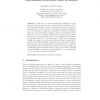Free Online Productivity Tools
i2Speak
i2Symbol
i2OCR
iTex2Img
iWeb2Print
iWeb2Shot
i2Type
iPdf2Split
iPdf2Merge
i2Bopomofo
i2Arabic
i2Style
i2Image
i2PDF
iLatex2Rtf
Sci2ools
IWSOS
2009
Springer
2009
Springer
Self-organized Evacuation Based on LifeBelt
Abstract. In this paper, we have investigated the feasibility of a selforganized evacuation process when compared with a centralized control. The evacuation strategy is based on ’predicted exit time’ (a relation of ’estimated time to reach to an exit’, ’exit capacity’ and ’exit population’) for each of the exit in a multi-exit environment, selecting the minimum value exit. The self-organized strategy is based on information propagation in a peer-to-peer fashion, initiated by a special agent in each of the exit area. The propagation range (’zone of influence’) is dependent on intensity and direction of peers interaction. Based on the propagated dataset, each agent can make an autonomous decision, conceptually a converse of centralized strategy where each agent is directed by a server. The evacuation process in supported by a wearable device, i.e. LifeBelt. Through large scale simulations using cellular automata technique and a challenging airport terminal model, we ...
Control Systems | Evacuation Process | IWSOS 2009 | Minimum Value Exit | Selforganized Evacuation Process |
| Added | 27 May 2010 |
| Updated | 27 May 2010 |
| Type | Conference |
| Year | 2009 |
| Where | IWSOS |
| Authors | Kashif Zia, Alois Ferscha |
Comments (0)

